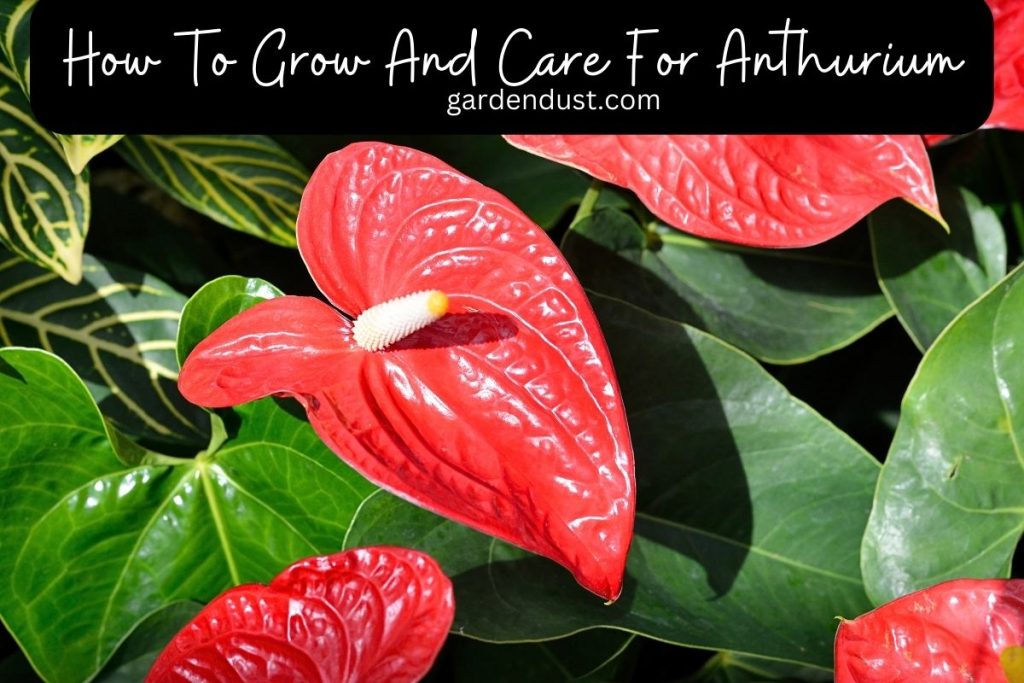Anthurium plants, also known as Flamingo flowers or Painter’s palette, are tropical plants native to the rainforests of Central and South America. They are well-loved for their striking foliage and unique flower structure, making them popular as both indoor houseplants and outdoor ornamental plants in tropical and subtropical regions.in this article we will discuss detail about how to grow and care for Anthurium. Lets begin…
Plant Description
The most recognizable feature of Anthurium plants is their large, glossy leaves that come in various shapes, including heart-shaped, lanceolate, or oval. The leaves can be green, dark green, or variegated with patterns of white, yellow, or pink.
Anthurium flowers are what truly make them stand out. The flowers consist of a colorful, waxy spathe (modified leaf) that wraps around a finger-like spadix, which contains tiny individual flowers. The spathe can be vibrant red, pink, orange, white, or even green, depending on the species or cultivar. Anthurium flowers are long-lasting and can provide a pop of color for weeks or even months.
Grow And Care
Anthurium plants are known for their attractive, glossy foliage and vibrant flowers. Here’s a general care and growing guide for Anthurium plants:
- Light:
Anthuriums prefer bright, indirect light. Avoid direct sunlight, as it can scorch their leaves. Place them near a north or east-facing window for optimal light conditions.
- Temperature:
Anthuriums thrive in temperatures between 60°F to 85°F (15°C to 29°C). Avoid exposing them to cold drafts or temperatures below 55°F (13°C).
- Watering:
Keep the soil evenly moist, but avoid overwatering. Allow the top inch of the soil to dry out before watering again. Anthuriums are susceptible to root rot, so it’s important not to let them sit in soggy soil.
- Humidity:
Anthuriums appreciate higher humidity levels. You can increase humidity by misting the leaves regularly or placing the plant on a tray filled with pebbles and water. Ensure the water level doesn’t touch the bottom of the pot.
- Soil:
Anthuriums prefer a well-draining potting mix. A mixture of peat moss, perlite, and orchid bark works well. Avoid using heavy soils that retain too much moisture.
- Fertilization:
Feed your Anthurium with a balanced, water-soluble fertilizer every two months during the growing season (spring and summer). Follow the instructions on the fertilizer package for proper dilution and application.
- Pruning:
Remove any yellow or damaged leaves to maintain the plant’s overall health. You can also prune the plant to control its size and shape. Use clean, sharp pruning shears to avoid any damage or infection.
- Flowering:
Anthuriums produce long-lasting flowers that come in various colors, including red, pink, white, and orange. To encourage blooming, provide proper care, including adequate light, humidity, and fertilization.
- Potting and Repotting:
Anthuriums prefer slightly crowded roots, so they don’t require frequent repotting. Repot the plant only when it becomes root-bound or every two to three years. Use a slightly larger pot and fresh potting mix during repotting.
Propagation
Anthurium plants can be propagated through a few different methods. Here are the primary methods of propagating Anthuriums:
- Division:
This method is suitable for mature Anthurium plants that have multiple stems or a clumping growth habit. Here’s how to do it:
- Carefully remove the plant from its pot and gently separate the roots and stems into individual sections.
- Ensure that each divided section has healthy roots and at least one stem with leaves.
- Plant each division in a separate pot, using well-draining soil.
- Water the newly potted divisions and provide them with the appropriate care as outlined in the previous response.
- Stem Cuttings:
This method involves taking a stem cutting from a healthy Anthurium plant. Follow these steps:
- Select a healthy stem with several leaves. Cut a 4-6 inch (10-15 cm) section from the tip of the stem, ensuring it includes at least one node (where leaves attach).
- Dip the cut end of the stem in rooting hormone powder (optional but can aid in rooting).
- Plant the cutting in a small pot with a well-draining soil mix or a mix of peat moss and perlite.
- Place the cutting in a warm and humid environment, ideally under a plastic bag or in a propagation tray with a clear plastic dome.
- Keep the soil slightly moist, but avoid overwatering. Mist the cutting occasionally to maintain humidity.
- After a few weeks, the cutting should develop roots. At that point, you can gradually acclimate it to normal growing conditions.
- Seeds:
While it is possible to propagate Anthuriums from seeds, it can be more challenging compared to the previous methods. Fresh Anthurium seeds have the highest chance of successful germination. Here’s a general guideline:
- Collect the seeds from a mature Anthurium plant. Clean them and remove any pulp or debris.
- Sow the seeds in a seed tray or small pots filled with a well-draining seed-starting mix.
- Cover the seeds lightly with the mix, as Anthurium seeds require light to germinate.
- Place the tray or pots in a warm and humid environment, preferably under a plastic dome or in a propagation tray.
- Keep the soil consistently moist, but not waterlogged.
- Germination can take several weeks to several months, so be patient.
- Once the seedlings have grown a few leaves and are large enough to handle, you can transplant them into individual pots.
- Propagation can be an exciting way to expand your Anthurium collection. Remember to provide the appropriate care and conditions for the newly propagated plants to help them establish and grow successfully.
These plants are often used as indoor houseplants, adding a tropical ambiance to living rooms, offices, or other well-lit areas. Some smaller Anthurium varieties, such as Anthurium andreanum, are also suitable for terrariums or as tabletop plants. In suitable outdoor climates, Anthuriums can be grown in shaded garden beds or as container plants on patios or balconies. Happy Gardening…






